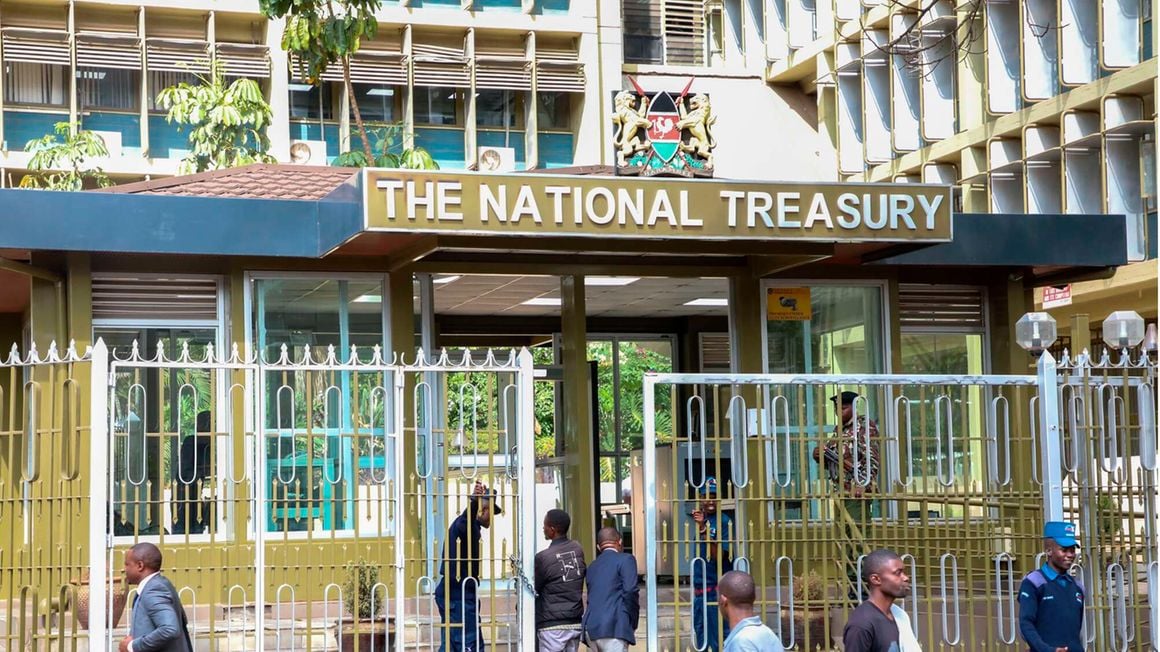
The National Treasury building in Nairobi in this picture taken on March 15, 2023. PHOTO | DENNIS ONSONGO | NMG
Kenya’s bilateral debt repayments towards China-funded infrastructure projects have grown by nearly half to a new record of Sh107.42 billion this financial year on the
back of increased clearance of principal sums after the grace period lapsed.The expenditure data published by Treasury Cabinet Secretary Njuguna Ndung’u shows the amount repaid to Chinese lenders was 46.19 percent more than Sh73.48 billion in the previous financial year.
This comes after the repayment moratorium ended four years ago.
The cash was largely wired to the lenders—Exim Bank of China and China Development Bank—in two batches of Sh58.89 billion in January and Sh48.53 billion in the first quarter of the current financial year before the Ruto administration came to power.
Read: China debt tax load slows down in Ruto's first budget
The debt costs for China are among the largest single expenditure votes this fiscal year ahead of big spenders like the Department of Basic Education whose full-year recurrent budget is estimated at Sh105.25 billion.
Notable votes with higher annual recurrent budgets are the Teachers Service Commission (Sh303.45 billion) and Defence (Sh135.08 billion).
Kenya under the administration of former President Uhuru Kenyatta largely took loans from China to build roads, bridges, power plants and the standard gauge railway (SGR) in a bid to spur economic activities and create jobs for growing skilled youth.
That borrowing binge started around 2014 after Kenya became a lower-middle income economy, limiting her access to highly concessional loans from development lenders such as the World Bank Group.
The Treasury report shows China’s total debt stock has, however, been declining in a post-Covid era largely on account of reduced new borrowing and repayments of principal amounts.
Kenya owed China $6.31 billion last March, the smallest volume since $6.01 billion in March 2019 after peaking in June 2021 at $7.06 billion.
The drop is in line with Beijing’s cautious approach to lending to Kenya and Africa in the post-Covid era amid warnings that key economies in the continent were facing a multitude of debt tripwires in the wake of a protracted global economic turmoil and could default on payments.
That slow-down investment in Africa’s infrastructural projects came after a few countries like Angola and Ethiopia struggled to honour obligations, while Zambia defaulted.
“Chinese debt has reached or it’s near point of diminishing returns if the big-ticket public expenditures in Kenya, for example, are anything to go by,” Churchill Ogutu, an economist with IC Asset Managers, an African-focused investment bank, said in an earlier interview.
“As such, I see China being selective in terms of projects they fund going forward.”
For the year starting July, for example, Chinese funding will plunge to a measly Sh1.74 billion from Sh29.5 billion in the current fiscal year and Sh71.2 billion in 2017, according to budget documents.
This comes at a time President William Ruto has made it clear that his administration will cut down on expensive foreign borrowing, including rich countries like China.
The bulk of China’s loans to Kenya were channelled through Exim Bank, which in May 2014 bagged the mega deal to fund as much as 90 percent of the $3.6 billion (about Sh494 billion under the prevailing exchange rate), 485-kilometre Mombasa-Nairobi SGR line.
The SGR deal saw Beijing overtake Tokyo as Kenya’s largest bilateral lender.
The terms of Beijing’s loan deals with developing countries are usually secretive and require borrowing nations like Kenya to prioritise repayment to Chinese state-owned banks ahead of other creditors, according to a dataset compiled by AidData — a US research lab at the College of William & Mary.
The dataset, based on an analysis of loan agreements between 2000 and 2019, suggested the Chinese deals have clauses for “more elaborate repayment safeguards” than its “peers in the official credit market”.
Exim Bank initially extended a grace period of five years which ended in 2019, obligating Kenya to start servicing the principal amount in addition to interest sums.
Read: China loans to Kenya fall for first time in 20 years
The debt repayment load to Chinese lenders is only dwarfed by servicing costs to commercial creditors, largely investors on the London and Irish stock exchanges through Eurobond and syndicated loans from international banks.
Repayments to those commercial creditors were Sh114.07 billion.
The Treasury data shows Kenya will not have a financial obligation to China Development Bank from the year starting July, trimming the budget for Chinese loans by 7.32 percent to Sh112.39 in the 2023-24 financial year from Sh121.26 billion estimates for the current year ending June.
→ cmunda@ke.nationmedia.com

No comments:
Post a Comment